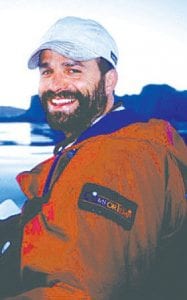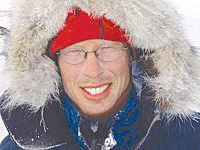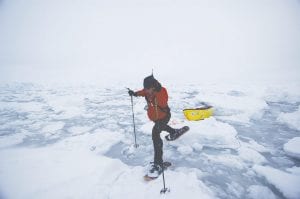At 9:22 a.m. Saturday, April 25, 2009, Cook County resident Lonnie Dupre and his companions, Maxime Edgard Chaya of Lebanon and Stuart Smith of Plano, Texas stood at the North Pole on cross-country skis.
Eight hours and eight minutes later, Tyler Fish of Ely, son-in-law of Grand Marais resident Lois Johnson and husband of Lois’s daughter Sarah LaKosky, stood at the North Pole on cross-country skis with fellow adventurer John Huston. On their way, they had stopped and said hi to Lonnie.
According to Lonnie, only 200 people have ever stood on the North Pole.
Tyler and John had to hurry in order to get to the pole before a helicopter – their last ride home – came to get them on the 61st day of their journey. Several days later, John wrote from Oslo, Norway on the expedition website (www.northpole09.com), “The last 66 hours of the expedition, …Tyler and I slept only three hours. …Around April 21…Tyler and I realized that the southerly drift of six to eight nautical miles per 24 hours was just too much for our current travel schedule and that we needed to do something extreme if we were going to succeed in our mission of becoming the first Americans to ski unsupported to the North Pole. …Tyler and I decided to travel for 12 hours, put up the tent and then sleep for one hour and have a meal and then about four hours later continue on our way toward the North Pole.”

Photo courtesy of Lonnie Dupre Left: Lonnie Dupre recently returned from the North Pole. His Peary Centennial North Pole Expedition was at the Pole on April 25.
The two men had prepared well physically and mentally for the journey and did a great job packing as well. “Our food resources, which we had rationed just perfectly,” said John, “held
out and we were actually able to up our calorie intake to 10,000 calories per 24 hours for those last few days. …Our fuel turned out just perfect as well. …Fuel is our lifeblood; without fuel we can’t cook and we can’t turn snow into water. …We reached the North Pole with… roughly two days of fuel.”
“We reached the North Pole exhausted and without enough energy for a jubilant celebration,” John wrote. John said from the pole via a satellite phone: “Of course, there is nothing here at the pole to signify our accomplishment, just a white, quiet expanse and some beautiful latitude and longitude readings on our GPS units.”

Photo courtesy of the family Above: Tyler Fish of Ely, son-in-law of Lois Johnson of Grand Marais, was at the Pole eight hours later with the Victorinox North Pole ’09 expedition.
At the pole, John wrote, “We are so tired we don’t know how tired we are. And we are enjoying our last meal in the tent together and having special dessert treats, a tiny bit of scotch and munching on a little bit of chocolate that is left over from lunch. …Whoa, that was a hard trip. We’re going to bed and are very, very, very happy to do so.”
From Oslo John wrote, “It’s hard to describe all the emotions coming together at that point that are still affecting us.”
Friends and family met Tyler and John in Oslo after their trip. “Tyler and I have started to fatten up a little bit,” John wrote. “I’m wearing shorts and a t-shirt – that feels so nice to be warm without having to work.”
Tyler and John started on March 2 with more than 650 pounds of gear. Only 22 people had ever skied unsupported from northern Canada to the North Pole before them. On their 487-mile journey, they battled fierce winds, long hours of winter darkness, -60-degree-Fahrenheit temperatures, snowstorms, and open water across which they swam with their gear. They had to navigate debris fields and pressure ridges that according to their website have increased dramatically over the past 20 years as ice has thinned.
Tyler and John expressed gratitude to all those who helped them reach their goal. “You can talk all you want about our perseverance, but we know in our hearts that we would not be standing in this spot without the support of everyone who believed in us,” John wrote.
One of the goals of the expedition, called the Victorinox North Pole ’09 Expedition, was to raise awareness and funds for CaringBridge, a Minnesota-based nonprofit offering free personalized websites to help people facing serious medical issues stay in touch with friends and family. On the CaringBridge website (CaringBridge.com) Tyler and John have written, “We believe that with compassionate support and an optimistic mindset all people have a limitless power to push beyond their perceived limits and reach their goals.”
Thesite goes on to say, “Huston and Fish are hopeful that their unique approach to taking on physical and mental challenges will inspire the families using and supporting CaringBridge.”
Before and during the trip, Tyler and John were subjects of study by the University of Minnesota Laboratory for Health and Human Performance in Extreme Environments. According to their website, “The focus of the research is on the relationship among personality, personal values, and personal growth over the course of the expedition and methods of coping with the challenges of an extreme environment.”
They also gathered data for the National Snow and Ice Data Center. “Due to society’s energy choices,” their website states, “the Arctic Ocean ice sheet is melting at an alarming rate.” Tyler and John offer an educational program focusing on “optimistic perspectives and responsible individual and community lifestyle choices in the face of this massive societal challenge.”
Lonnie Dupre’s Peary Centennial North Pole Expedition was named in honor of Robert Peary who along with Matthew Henson and a team of Inuit became the first known men to reach the North Pole. Lonnie also hopes to bring attention to the dangers of melting polar ice caps. In a video on his website (www.pearycentennial. com), Lonnie said that sea ice, “the thermostat that keeps our hemisphere cool,” was 12-15 feet thick when Peary was there. “Scientists predict an ice-free Arctic in summer as early as 2013,” Lonnie wrote. “…Governments and companies have remained blindly focused on new Arctic shipping lanes to extract from the ocean’s floor the very thing that is causing the rise in global temperatures – fossil fuels. The thawing Arctic ice sheet is opening the door for the exploitation of billions of tons of gas and oil, valuable minerals and new untapped fishing stocks.”
The purpose of Lonnie Dupre’s Peary Centennial North Pole Expedition was twofold: to encourage governments to enter an international Arctic treaty to protect Arctic marine life and the culture of the four million indigenous people who live within the Arctic Circle; and to develop a campaign to illustrate the link between global warming, excesses in the lifestyles of people in developed countries, and poor energy policies.
Old, multi-year ice floes were rare along Lonnie’s 650-mile, 53-day journey. The actual distance from Lonnie’s starting point to the North Pole was 480 miles, but to avoid open water he and his team had to go out of their way to find ice that could bear their weight. They also suffered a “treadmill” effect as they neared he pole, with ice floes carrying them away from the pole as they tried to get near it.
From Bergen, Norway on May 4, Lonnie congratulated Tyler and John. He said he was still extremely weak a week after finishing his own trip. “I’m getting better each day and looking forward to getting home,” he said. He was expected in the Twin Cities May 8. Until then, he was “spending a little time running numb toes through warm green grass.”
Lonnie will show photos and talk about his expedition at 7:00 p.m. May 22 at North House Folk School. Proceeds from the event will benefit the Suprenant family. For more information, contact dupre@boreal.org or call Kelly Dupre at (218) 370-1178.
This year, another Cook County resident, Eric Larsen, plans to begin a journey that will take him to the top, bottom and roof of the world within 365 days. According to his website (www.ericlarsenexplore.com), no one has reached both the North Pole, the South Pole, and Mount Everest within one year, and only 15 people (no Americans) have been all three places.
This will be Eric’s second trip to the North Pole. In 2006, he and Lonnie Dupre reached the North Pole together by canoe in the first expedition to reach the pole over summer sea ice. On his website, he also congratulated Tyler and John on their accomplishment.
Eric’s website states, “The polar regions of the world are home to an amazing variety of life. Seemingly desolate and vacant, these areas support vital ecosystems and are integral to regulating and maintaining world climate. The ‘Save the Poles’ expedition will journey to these last frozen places in an attempt to tell their amazing story.”
Eric’s objectives include a plan to promote clean energy solutions, advocate for strategies to reduce carbon emissions past the end of the Kyoto agreement in 2012, and collect relevant scientific data.
Eric has written that a 1,250-square-mile ice shelf recently collapsed off the coast of Antarctica and disintegrated into the Southern Ocean and that snow and ice that once stretched to Edmund Hillary’s Mt. Everest base camp doesn’t start for five miles further up the mountain.
All three groups are watching for global signs in the coldest, most remote areas of the world and hope that people will join their efforts to preserve the health of the environment. Tyler and John’s website states, “Some argue that it is in the Arctic that we will see the clearest signs of the future.”



Loading Comments